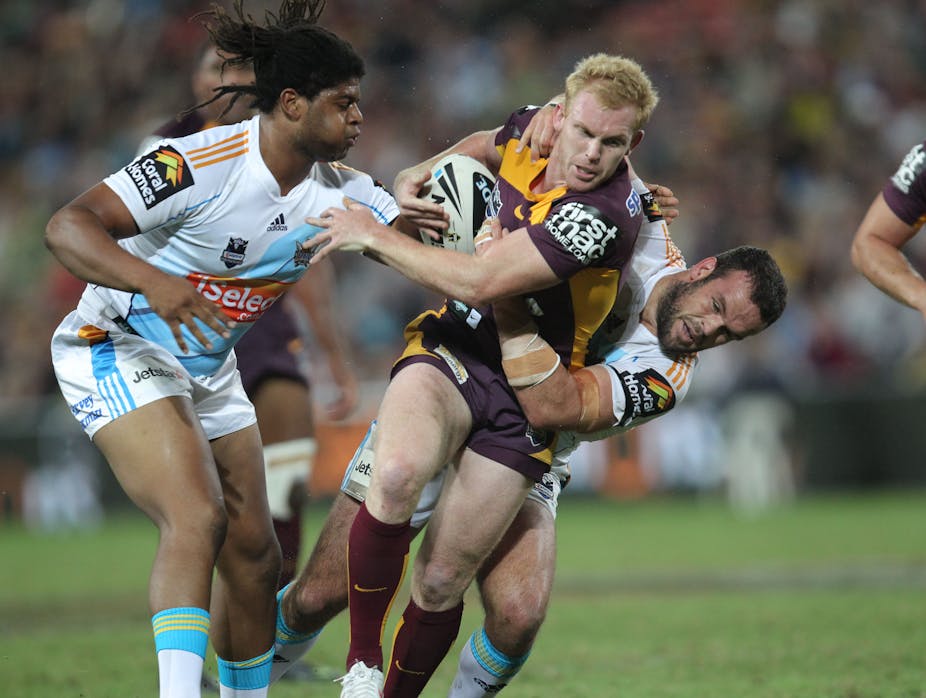“He got a free trip to Disneyland.” That’s how Wally Lewis described the knockout of Nate Myles, from the Gold Coast Titans, during a tackle two weeks ago. Rugby league is a tough game with tough players; according to the running commentary on the club’s Twitter account, Myles “elected to play on” despite copping a sickening accidental knee to the head.
Many people simply assume concussion means being “knocked out.” A loss of consciousness is a classic symptom, but it doesn’t have to happen for a concussion to take place. Diagnosing concussion isn’t always straightforward and requires navigating through a grey area of indicative symptoms such as dizziness, balance problems, blurred vision, headache and memory loss – some of which are fleeting and not always present.
The typical elite footballer’s career lasts only a few seasons, but how do players who have suffered a concussion fare years after they retire?
America’s National Football League (NFL) has been the target of lawsuits from retired players who claim the cognitive problems that emerged with age were caused by the poor management of concussions they suffered on the gridiron field decades ago.
Postmortem examinations of athletes who suffered concussions have also revealed brain degeneration associated with dementia-like symptoms. And multiple concussions appear to be a risk factor for developing cognitive problems later in life.

But it’s difficult to determine whether head trauma directly causes these problems from case reports alone. If we are to have a clearer understanding of the long-term effects of head injuries on the football field, we need a more determined research effort to track a footballer’s playing history using standardised and objective measures over a longer period of time.
In Australia, it’s important for those who run our favourite brands of collision sports to help with such research, even though it it’s likely to raise uncomfortable questions about how concussion is managed.
Only recently have Australian Rules football, rugby league and rugby union come up with procedures to better deal with concussion. Guidelines now adopted by the codes at the elite level say concussed players should be removed from the match and not allowed to return.
But a number of ethical issues may impact the diagnosis of concussions. Team doctors have an obligation to their employer (the football club), and the best interests of the team/coach/club may not necessarily be in the best interests of the player. A diagnosis of concussion should exclude him from the remainder of the match, but confirming this diagnosis depends on the assessor.
Winning is clearly important for the team, so in some cases, it will be better to have their star player on the field, even if they aren’t fully fit to play after a knock to the head.

Both the National Rugby League and Australian Football League guidelines advise assessors not to be “swayed by the opinion of the player, coaching staff or anyone else suggesting premature return to play.” This acknowledges that pressure may be placed on medical staff. It also leaves the guidelines open to suspicions that a diagnosis of concussion depends on the circumstances of the match and who the player is.
The last thing we want to see is head injuries being under-reported, so the guidelines must be resistant to other manipulations. And not allowing concussed players to return to the field in the same match is sensible move.
But the guidelines do nothing to prevent concussions occurring in the first place. It’s tempting to suggest that padded headgear is made compulsory, but even here, the evidence is not clear.
Some research suggests that rugby union players who wear headgear may act in a riskier way on the field because they (perhaps wrongly) feel safer. The evolution of crash helmets in American Football has seen them become a weapon rather than something to protect a vulnerable part of the body.
Of course, thousands of amateur and youth footballers also do battle on the field, and by the time a player makes it in the big league he’s already played for years in lower grades. It’s here that many more concussions likely go unrecognised and mismanaged. If the elite level takes concussion seriously, then hopefully amateur levels will follow.

Next steps in research
There are a number of potential avenues for future research in this area. But surveys that rely on players self-reporting concussions may not produce the most reliable data, especially if the players are asked to recall incidents that may have happened years ago.
A “brain bank” may help us understand the link to neuro-degeneration, but this relies on sufficient numbers of ex-players donating their brains to science after they die.
We need to monitor players as they come through the grades and then into retirement using reliable neuropsychological measures, perhaps including new imaging technologies. Hopefully then, we’ll have a better understanding of the long-term impacts of sports-related concussions.
Football (whatever the code) has long been a valuable source of inspiration, entertainment and recreation for millions of Australians. Let’s try to keep it that way for generations to come.

